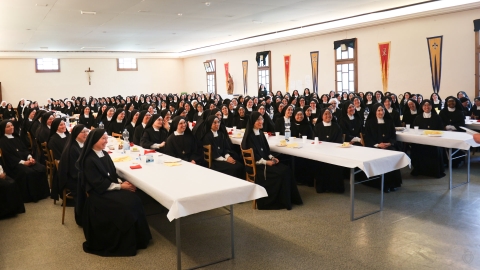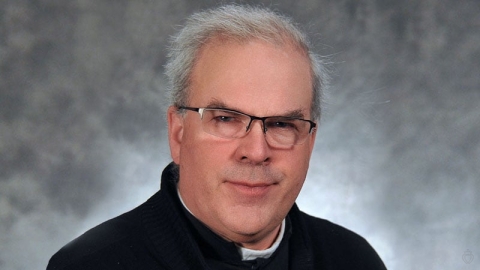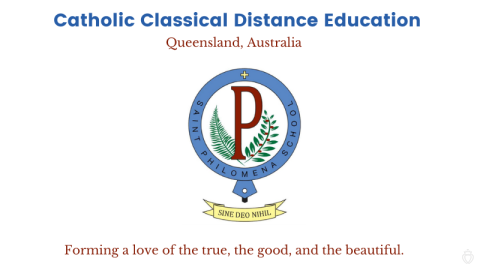A Look at the Religious Life: Disciples of the Cenacle

The article aims at taking a look at a little known Traditional Italian group of nuns affilated with the Society of St. Pius X. They are more often well known for their great work with the famous publication 'Sisi NoNo". The amazing work they do and the assistance that they render the Priests of the SSPX in Italy can never be praised enough.
Below is a description about their history and work along with their contact information. . .
Disciples of the Cenacle
Spirituality
The Disciples of the Cenacle form a small community of Sisters who, "hid with Christ in God" (Col. 3:3), wish, as far as possible, to conform their existence to the teaching of the Redeemer, who is "the Way, the Truth, and the Life" (Jn. 14:6).
Their founder was Fr. Francesco-Maria Putti, a Roman priest and beloved spiritual son of Padre Pio, who guided and formed them until his death in 1984. In a memorandum he wrote at the time (April 10, 1965) to the Vicar General of the Archdiocese of Salerno, the ancient Italian coastal city south of Naples, Don Putti himself relates how the first cenacle came to be:
In carrying out my ministry, I had the opportunity to get to know and to guide some high school girls and university students, as well as some who had already completed their studies. Some of them expressed their desire to be able to consecrate their lives to the Lord in a life of prayer and action which could be of service to the Church.
After much reflection, and after having sought advice and having verified the existence of a common aspiration among them, a small group of these young women was formed. The general purpose of the community is to hasten the advent of the kingdom of God, the sanctification of its members, and that of obtaining, through the communion of saints, the sanctification of the priestly ministry and the conversion of sinners. The specific end is the exercise of whatever activity may be of service and at the same time consonant with a life of prayer, action, and sacrifice in a cenacle of reparation.
A Good Start
In June of 1965, the first four Sisters began their life in common. Soon, the Archbishop of Salerno, Demetrio Moscato (1945-68), gave them a big house near Salerno, and Don Putti drafted a general statute, which he sent to the archbishop on November 21, 1966, communicating to him that, despite numerous difficulties, they already had ten vocations. Thus, at the very time when the disastrous post-conciliar period was starting, there began in the Church a new institute, the Disciples of the Cenacle.
Peregrinations
Almost all of the first young Sisters taught in public schools. Their teaching supported the little community, and it was a form of apostolate. Having left their respective families, they perfected their consecration to the Lord by uniting the contemplative life to an active life. Their families, in general, could not understand their sudden resolution, which struck them as a lark, a leap from a safe and respectable situation into the unknown.
During summer vacations and whenever they could, the Disciples went to San Giovanni Rotondo in order to nourish their souls near Padre Pio. They had permanently rented a little house near the monastery. Don Putti wanted the Disciples to live as long as possible at San Giovanni Rotondo so that they could benefit from the example of Padre Pio's life, his merits, his confessional, and his counsels. From Padre Pio and Don Putti, the Sisters learned to love the Holy Sacrifice of the altar. Following their founder's directives, they remained faithful to the Latin Mass.
At Salerno, the community's life went serenely along, even in its relations with the archbishop. But soon, clouds formed....Don Putti informed the Sisters of the difficulties which had arisen in their relations with the archbishop. He explained to them the reasons compelling them to leave for another region. After a year at Grottaferrata, a walled medieval town a short distance south of Rome famous for St. Nilus Abbey, and two years at Frascati, also in the Roman region, the little community settled on the Via Anagnina near Grottaferrata in 1971 and remained there until 1983. But Don Francesco wanted to acquire a house. A donation from a monsignor, a very eminent benefactor, enabled them to acquire their present house at Velletri, not far from the SSPX's priory at Albano Laziale south of Rome, an acquisition that was completed on October 4, 1984, by the purchase of a neighboring parcel with a little house which they renovated for use by the community's chaplains and guests.
Don Putti's Legacy
Don Putti bequeathed to his Sisters the press apostolate of SiSiNoNo, a periodical he started in 1975 [an English-language edition has been published by Angelus Press since 1994–Ed.], by which he sought to check "the growing desert of the true faith, whether in those who should be responsible for teaching it, or those who should learn it." As stated in the editorial of the inaugural issue, SiSiNoNo's mission was "the thankless task of going against the flow by saying yes to everything which, according to the Catholic Faith, was taught by the Apostles, and by saying no without equivocation or compromise to everything that seeks to supplant it." So it was that during the 1980's the Sisters began to leave the field of education in order to better help Don Putti in his SiSiNoNo apostolate. After his death, a priest of the SSPX became editor-in-chief of the periodical, which continues to be published monthly. Under the direction of the editor-in-chief, the Sisters do all the production work for SiSiNoNo from copy editing and typesetting to mailing. They currently print 3,500 copies monthly, but to this number must be added the circulation of English, French, and Spanish editions of this unique newspaper which is read in the Vatican and worldwide.
Religious Life
After Don Putti's death, the community was assisted spiritually by the Society of Saint Pius X and by Msgr. Francesco Spadafora (d. 1997), a renowned exegete and professor at the Pontifical Lateran University. The chaplaincy of the community is still provided by priests of the Society of Saint Pius X, while authority in the community is vested in the Mother Superior, who is responsible for decisions over their daily life and apostolic works.
The Disciples of the Cenacle are a religious institute of simple vows. Postulants must be of age in order to be accepted, although exceptions may be examined by the Mother Superior and her council. The Community does not require a dowry or a specific trousseau; each one may bring what she can for her use. Good health is not necessary; however, persons with nervous conditions or contagious disease are not accepted. The postulancy lasts one year and the novitiate, two, at the end of which the aspiring religious makes her first temporary vows of poverty, chastity, and obedience. Vows are renewed annually; perpetual vows are made the tenth year.
Timetable of the Community
6:00 a.m. Rise
6:20 Morning Offering, Lauds, meditation and Holy Mass
8:10 Breakfast
12:00 Angelus and a short visit to the Blessed Sacrament
1:00 p.m. Dinner, Recreation time
4:00 Way of the Cross or Second Meditation
6:00 Rosary, Vespers
8:00 Supper, Recreation time
9:00 Compline
For information contact:
Rev. Mother Superior
Le Discepole del Cenacolo
Via Madonna degli Angeli 14
I-00049 Velletri, Roma
[39] (06) 963-5568
Email: [email protected]
Source text: Angelus Online





